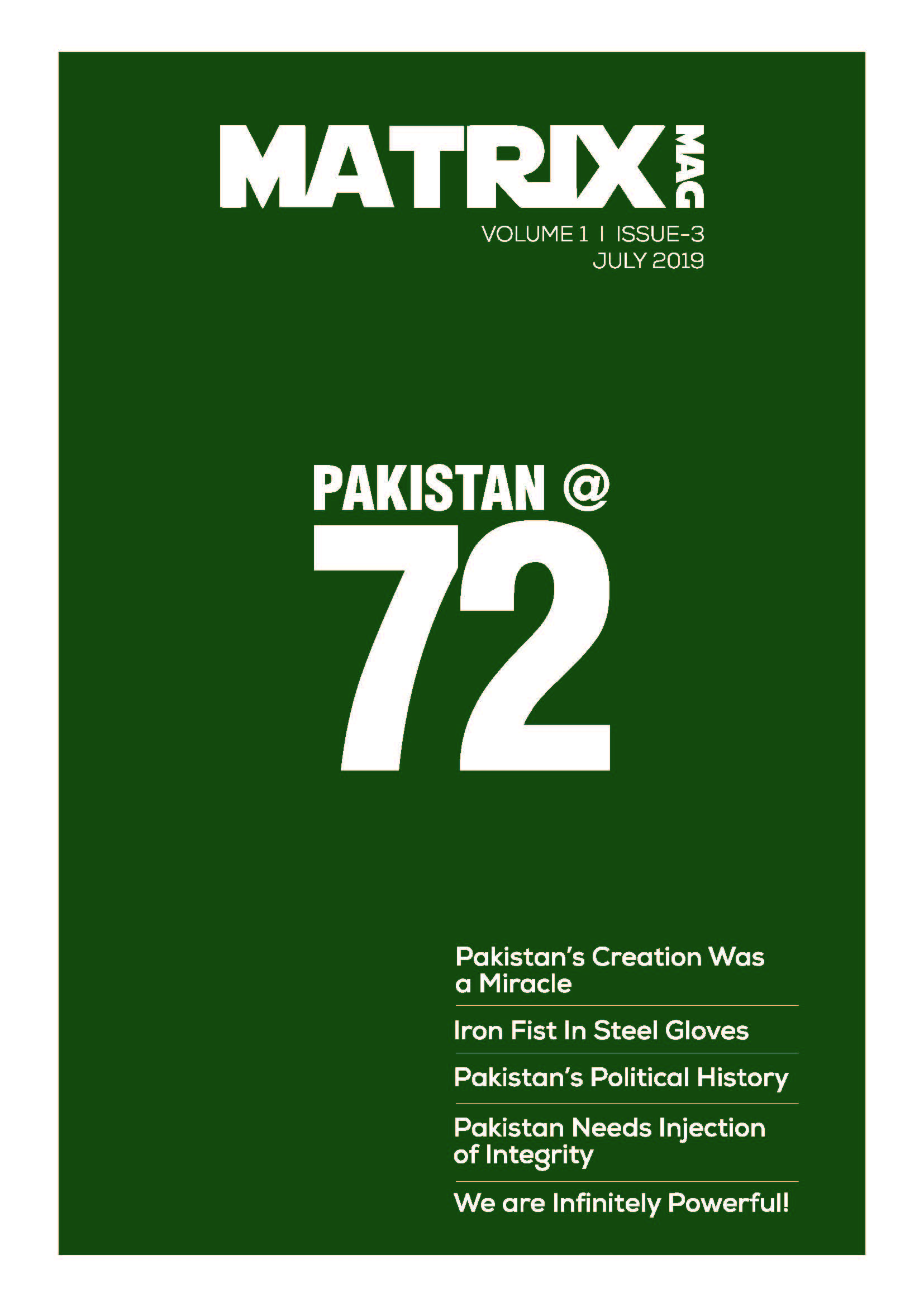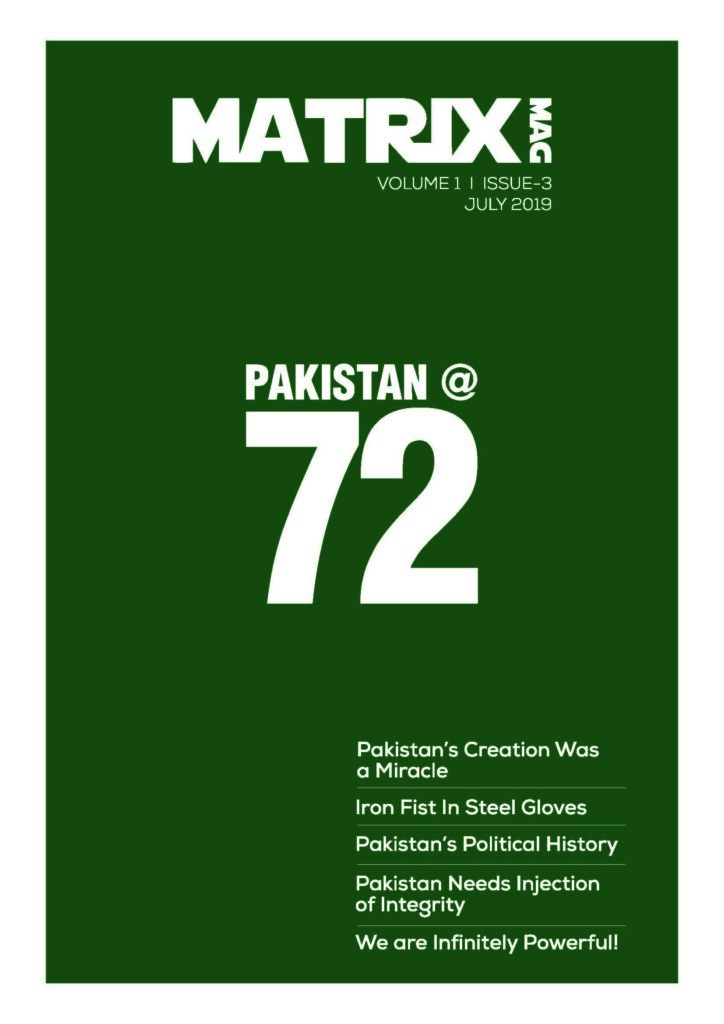Download Matrix Mag July Issue here
Muhammad Ziauddin
From special coercive laws to blatant censorship, the Pakistani media has witnessed many forms of oppression in its 72 years of struggle-filled existence.
But what the media endured in 2018 and since also includes an unprecedented level of imposed “self-censorship” through tactics unbecoming of a responsible state. Those who refuse to fall in line suffer a loss of readership and viewership. Unjustified cover-ups and the suppression of truth regarding crucial questions of public accountability have seriously affected the perception of the quality of democracy in Pakistan.
History
In the very first decade of our independence, harshest of colonial press laws were employed to suppress the media. Since the second decade until up to the late 1980s, media were silenced using a law known as the Press and Publication Ordinance. And many newspapers were taken over by the government and functioned under what was called the National Press Trust.
During General Ziaul Haq’s rule, the media were subjected to the worst kind of censorship. At the beginning of his diabolic term, the General had filled the jails with protesting journalists. He even had some of us subjected to public lasdhing.
During the Musharraf era, the broadcast media industry was opened for the private sector but licenses were issued doing away with the cross-media ownership law. The side-effects of this policy were devastating.
When the chips were down for him in 2007 as the lawyers’ movement peaked, Musharraf came down heavily on the very private broadcast media that he had allowed being set up so earnestly.
Imran wary of the media
In an interview with a US think tank during his recent visit to the US, Prime Minister Imran Khan said that the media in Pakistan is freer than that in Britain, adding “it is not just free but it is out of control”.
However, a look at how the government had tried to control the media highlights the gulf between the government’s words and its actions.
Download Matrix Mag July Issue here
During the ten years leading to his emergence as the Prime Minister, heading a PTI-led coalition government, Imran Khan was the darling of the media not only because of him having been a world-class cricketer, a successful social worker, and a celebrity known almost the world over but also because both Nawaz and Zardari, to say the least, were suffering from the incumbency factor then.
Now the roles are somewhat reversed. He is in power.
Therefore, he gets the media flak that incumbents usually do. But he refuses to accept this reality and views even constructive criticism of his policies and style of his governance by media with a lot of wariness. Therefore, his mistaken belief that the media has gone out of control.
Today the no go areas are very well delineated in some cases but most of the time it is like playing blind in a card game only to end up being censored at show time. No intrusive reporting on missing persons, nothing on what is really happening inside Balochistan or in the war zone adjacent to the Afghan border or in the IDP camps. No intrusive reporting on counterinsurgency strategy. Nothing on attempts to mainstream terrorists caught red-handed except spot news. Nothing on the formation, funding and arming of proxies. Nothing on Pashtun Tahfuz Movement (PTM) and interviews and public protests of opposition leaders (under NAB investigation), especially the rallies being addressed by Maryam Nawaz.
Indeed, media in Pakistan is facing serious intimidation, restrictions on the sale and circulation of newspapers as well as the blockading of television broadcasts by the authorities. A climate of fear impedes media coverage of abuses both by government security forces and militant groups.
Download Matrix Mag July Issue here
In August 2016, the government also enacted the Prevention of Cybercrimes Act, which allows the government to censor online content and to criminalize internet user activity under extremely broad and vague criteria. The law also sanctions government authorities to access data of internet users without judicial review or oversight.
Dawn, whose circulation has been continuously disrupted, has also claimed that, since October 2016 that is soon after the publication of what is called Dawnleaks on October 6, 2016, it has suffered a complete ban on advertising from organizations falling under the domain of the ISPR, including DHA and other commercial establishments.
A number of cable operators have complained of having been compelled to take certain channels off-air or to move them to the very end, thereby making them less accessible.
Dawn is perhaps, the most influential newspaper in Pakistan and the combined reach of news and views of Geo-Jang-The News makes it the market leader by lengths. The message that went to the entire industry was that if these two prominent media houses could be targeted in the form of disruptions of circulation and transmission with complete impunity the lesser one’s better fall in line lest they are made to pay a heavier price in case they try to take ‘foolish’ chances!
A common consequence of ‘disobeying’ instructions is vicious character assassinations through anonymous social media accounts and social networking platforms that go so far as to incite violence against media persons – and in the case of women, rape threats.
At least seven editors and reporters in GB have testified to receiving threats with dire consequences if they do not comply. In one case, an editor and publisher who did not comply were accused of being on the payroll of foreign spy agencies.
Download Matrix Mag July Issue here
One of the major reasons for the establishment to be acting with such complete impunity is the failure of the working journalists to speak in one voice. The Pakistan Federal Union of Journalists (PFUJ) is too splintered. Many had been either compromised or were too afraid to take a strong stand.
Just over a year ago, the transmission of Geo News and all of the four other channels owned by Geo TV was suspended for several days throughout at least 80% of the country in an apparent reprisal for its overly independent news coverage. No official suspension order ever emerged but the military was widely blamed because they control the network distribution cables in every district.
Five well-known bloggers were kidnapped in different parts of Pakistan within a few days of each other in January 2017 and were held for several weeks before being released. One of the five who has since fled the country, Ahmed Waqass Goraya, says the abductions were carried out by the intelligence services with the aim of intimidating online dissidents.
Gohar Wazir, a Khyber News TV reporter was arrested on the evening of 27 May this year after covering a meeting convened by a Pashtun tribal defence movement to denounce army abuses in the former Tribal Areas along northwestern Pakistan’s border with Afghanistan.
Shahzeb Jillani, an investigative reporter in April this year faced charges of violating four articles in the 2016 Prevention of Electronic Crimes Act and two criminal code provisions. The charges include “defamatory remarks against the respected institutions of Pakistan” and “cyber-terrorism.” The case had been designed to intimidate and silence journalists. He was set free later when the accusers could not prove their charges.
Jillani said that he believed that the real reason for the charges was his recent story on missing persons, and his 24 March tweet criticizing the decision to decorate a senior military intelligence officer “widely accused of political engineering” during the July 2018 election.
Download Matrix Mag July Issue here
The rise of the internet and the emergence of new means for advertisers to reach their target audience is said to be diverting increasingly advertisements from conventional TV and print media to social media. The size of the advertising cake has increased over the years, but so has the number of claimants. The competition for advertising income has increased sharply.
Meanwhile, the number of people using smartphones now exceeds the number of TV screens in the country. So, it’s not just economics that is affecting the industry. Audiences are turning away. Younger people are looking at other platforms for information and entertainment.
Both the newsroom and the journalist will have to change to meet this new challenge. Newsrooms cannot restrict themselves to one medium or language. Neither can journalists. Most journalists will now have to improve their skills to be able to report for different platforms. They will have to immerse themselves in social media in a bid to connect to their new audiences. News will change in the manner it is made and delivered.
State of the media in the region
The state of the media in the three countries of the subcontinent (India, Pakistan and Bangladesh) and Turkey is far from ideal. In fact, in all these four countries media has to a large extent lost its public service characteristics having been captured by corporate vested interests and also suffers from suppressive controls of the governments of the day. Fake news is not a new phenomenon in these countries. However, since the advent of social media fake news, post-truth and alternate truth have become almost like a new norm. It is political populism that is now being propagated by the regular media, the world over.
The author is a renowned and respected Pakistani print journalist of 50 years’ standing. He is also the former Executive Editor, The Express Tribune.





